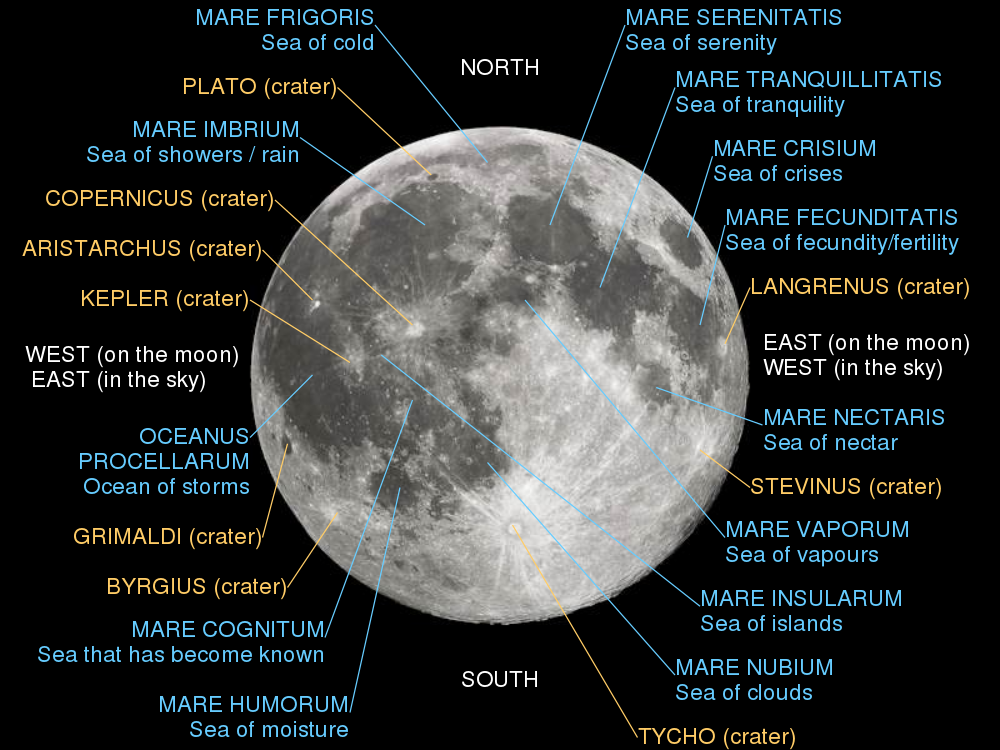
Caption: An image moon map of the near side of the Moon with the major maria (singular mare, vocalized mar-ray) and lunar craters identified.
Features:
- This is an image Moon map with labels.
The lunar phase is full moon or, maybe, waxing gibbous moon just before full moon.
- The near side of the Moon is
the only one we see from Earth.
- The near side
is actually the most interesting side to look at and probably for
lunar geology because of the large
maria (singular mare).
Maria means "seas" in Latin. The early telescopic observers of the 17th century thought the maria might be seas. They soon realized this was wrong. However, the name is still appropriate since the maria are lava plains: i.e., the frozen seas of lava from lava flows welling up from the interior of the young maria formed 3.5--3 Gyr ago though some might be have formed as recently as 1.2 Gyr ago (see Wikipedia: Lunar mare: Ages).
The far side of the Moon has only small maria and looks rather bland and uninteresting compared to the near side.
The maria actually cover only ∼ 16 % of the lunar surface, but they look more extensive to Earthlings just because they cover ∼ 30 % of the near side (see Wikipedia: Lunar Mare).
- The part of the
lunar surface
which is NOT
maria
is the lunar highlands.
It is the early surface of the
Moon
and is much more heavily cratered than the
maria.
This is because the
lunar highlands
were subjected to the
heavy bombardment
in the early Solar System
(4.6--3.8 Gyr ago), whereas the
maria formed mostly later.
The heavy bombardment
was due to the fact that the
Solar System
had far more bodies then than now
(protoplanets
and planetesimals)
that were mostly
lost through impact events
or ejection from
the Solar System
by gravitational assists.
- The Moon has the orientation it would have
on the celestial sphere with
equatorial coordinate system
directions
north at the top,
south at the bottom,
east at the left,
and west at the right.
This is the conventional orientation for modern images and maps of the Moon.
- The
Mare Tranquillitatis (AKA Sea of Tranquility)
is west of the north-south line at about mid
north latitude.
The first crewed landing on the Moon occured there with Apollo 11 in 1969. The landing crew consisted of Neil Armstrong (1930--2012) and Buzz Aldrin (1930--). The third crew person Michael Collins (1930--) stayed in lunar orbit.
- The obvious lunar crater
in the south is Tycho---which is the
one lunar crater most people remember.
Tycho is the most obvious rayed crater---it has large radial rays emanating from it that are fallback from giant plumes that were ejected when the Tycho impactor impacted.
The rays indicate that Tycho is relatively young impact crater. The rays of impact craters are erased by space weathering over gigayear time scales. Tycho is estimated to be 108 Myr old (see Wikipedia: Tycho: Age and Description).
- The names of the large features were given long ago before 1881
anyway: see Map of the Moon,
Andrees Allgemeiner Handatlas, 1st Edition, Leipzig (Germany) 1881, p. 4,
but note that the south is at the top in that map.
- Labeled Moon features:
-
Crater Aristarchus,
Crater Byrgius,
Crater Copernicus,
Crater Grimaldi,
Crater Kepler,
Crater Langrenus,
Crater Stevinus,
Crater Tycho,
Mare Crisium,
Mare Cognitum,
Mare Fecunditatis,
Mare Frigoris,
Mare Humorum,
Mare Imbrium,
Mare Insularum,
Mare Nectaris,
Mare Nubium,
Mare Serenitatis,
Mare Tranquillitatis,
Mare Vaporum,
Oceanus Procellarum.
For more Moon features, see Wikipedia: List of lunar craters, Wikipedia: List of lunar features, Wikipedia: List of lunar maria, Wikipedia: List of lunar mountains and mountain ranges.
- Yours truly's favorite lunar mare is Mare Imbrium---it's big, it's round, it's flanked by those five great craters: Archimedes (not labeled on the image, but on the selenographic southeast edge of Mare Imbrium), Aristarchus, Autolycus (not labeled on the image, but on selenographic east edge of Mare Imbrium; named for Autolycus of Pitane (360?--290? BCE) and NOT for the grandfather of Ulysses, Autolycus (Wolf-Himself, Very-Wolf)), Copernicus, Kepler.
Image link: Wikipedia: File:Moon names.svg.
Local file: local link: moon_map_side_near.html.
File: Moon map file: moon_map_side_near.html.